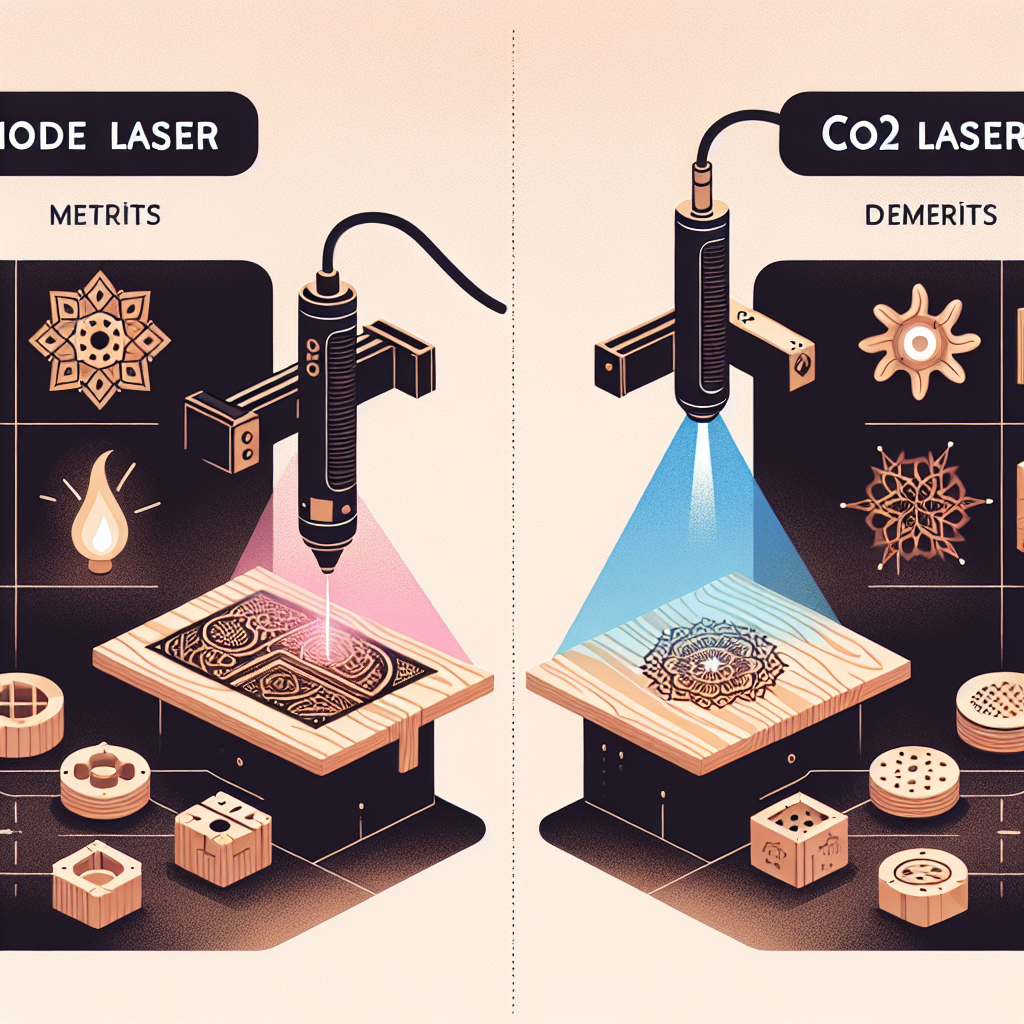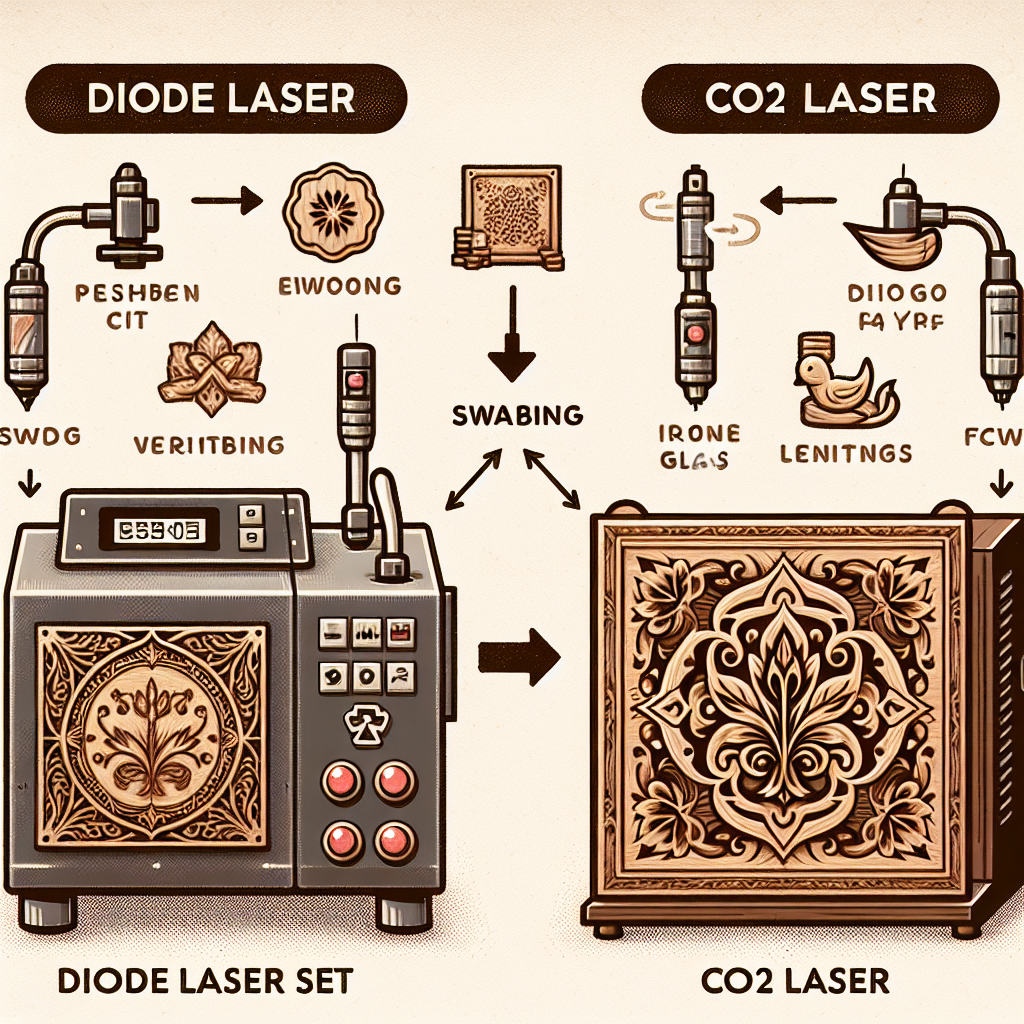-
Table of Contents
Diode Laser vs. CO2 Laser: Comparing Merits and Demerits for Home Decor Products
Diode lasers and CO2 lasers are two commonly used types of lasers in the field of home decor products. Each type has its own merits and demerits that should be considered when choosing the appropriate laser for specific applications. In this article, we will discuss the advantages and disadvantages of diode lasers and CO2 lasers in the context of home decor products.
Sure, I can do that. Please go ahead and ask your question.
Advantages of Diode Laser for Home Decor Products
Diode Laser vs. CO2 Laser: Merits and Demerits for Home Decor Products
When it comes to creating stunning home decor products, laser technology has become an increasingly popular choice. Among the various types of lasers available, diode lasers and CO2 lasers are two commonly used options. Each of these lasers has its own set of advantages and disadvantages, making it important to understand their merits and demerits before deciding which one to use for your home decor projects.
One of the major advantages of using a diode laser for home decor products is its compact size. Diode lasers are small and portable, making them ideal for small-scale projects or for those who have limited space in their workshop. Additionally, diode lasers are known for their high precision and accuracy. They can produce intricate designs and fine details with ease, allowing you to create beautiful and intricate home decor pieces.
Another advantage of diode lasers is their energy efficiency. These lasers consume less power compared to CO2 lasers, making them more cost-effective in the long run. This is particularly beneficial for those who plan to use their laser for extended periods or have a high volume of production. The energy efficiency of diode lasers also means that they produce less heat, reducing the risk of damage to the materials being worked on.
Furthermore, diode lasers offer a wide range of wavelength options. This versatility allows you to work with different materials, such as wood, acrylic, and even certain metals. Whether you are engraving a wooden plaque or cutting intricate patterns on acrylic sheets, a diode laser can handle the task with precision and ease.
However, it is important to note that diode lasers also have their limitations. One of the main drawbacks is their limited power output. While diode lasers are suitable for small-scale projects, they may not be powerful enough for larger or more demanding applications. If you are planning to work with thicker materials or require higher cutting speeds, a CO2 laser might be a better choice.
Additionally, diode lasers are generally more expensive compared to CO2 lasers. The advanced technology and precision they offer come at a higher price point. Therefore, if you are on a tight budget or do not require the high precision offered by diode lasers, a CO2 laser might be a more cost-effective option.
In conclusion, diode lasers offer several advantages for home decor products. Their compact size, high precision, and energy efficiency make them ideal for small-scale projects. The wide range of wavelength options also allows for versatility in working with different materials. However, it is important to consider the limitations of diode lasers, such as their limited power output and higher cost. If you require more power or have budget constraints, a CO2 laser might be a better choice. Ultimately, the decision between diode lasers and CO2 lasers for home decor products depends on your specific needs and preferences.
Disadvantages of Diode Laser for Home Decor Products
Diode lasers have gained popularity in recent years for their wide range of applications, including home decor products. However, like any technology, diode lasers also have their disadvantages. In this article, we will explore the drawbacks of using diode lasers for home decor products and compare them to the merits of CO2 lasers.
One of the main disadvantages of diode lasers is their limited power output. While they are suitable for small-scale projects, such as engraving or cutting thin materials, they may not be powerful enough for larger and more demanding tasks. This limitation can be a significant drawback for those looking to create intricate and detailed designs on thicker materials, such as wood or metal.
Another drawback of diode lasers is their wavelength. Diode lasers typically operate at a shorter wavelength compared to CO2 lasers. This shorter wavelength can result in less precise cuts and engravings, especially when working with materials that are highly reflective or have a high thermal conductivity. The lack of precision can be a significant disadvantage for those seeking to create intricate and flawless designs on their home decor products.
Furthermore, diode lasers are generally more expensive than CO2 lasers. The cost of diode lasers can be attributed to their complex design and the advanced technology used in their manufacturing. This higher cost can be a deterrent for individuals who are on a tight budget or those who are just starting their home decor business. Additionally, the higher cost of diode lasers may not be justified for those who only require occasional use or have limited projects to work on.
In addition to the higher cost, diode lasers also require regular maintenance and calibration. This maintenance can be time-consuming and costly, especially for individuals who are not familiar with laser technology. CO2 lasers, on the other hand, are generally more straightforward to maintain and require less frequent calibration. This ease of maintenance can be a significant advantage for those who value convenience and efficiency in their home decor projects.
Lastly, diode lasers have a shorter lifespan compared to CO2 lasers. The continuous use of diode lasers can lead to a decrease in their performance and efficiency over time. This decrease in performance can result in lower-quality cuts and engravings, which can be frustrating for individuals who strive for perfection in their home decor products. CO2 lasers, on the other hand, have a longer lifespan and can maintain their performance and efficiency for a more extended period.
In conclusion, while diode lasers have their advantages in the realm of home decor products, they also have their fair share of disadvantages. The limited power output, shorter wavelength, higher cost, regular maintenance requirements, and shorter lifespan are all factors that need to be considered when choosing between diode lasers and CO2 lasers. Ultimately, the choice depends on the specific needs and requirements of the individual or business.
Merits and Demerits of CO2 Laser for Home Decor Products
CO2 lasers have been widely used in various industries, including the home decor industry. These lasers offer several advantages that make them a popular choice for creating intricate designs on home decor products. However, like any technology, CO2 lasers also have their limitations and drawbacks. In this article, we will explore the merits and demerits of CO2 lasers for home decor products.
One of the major merits of CO2 lasers is their versatility. These lasers can cut, engrave, and etch a wide range of materials commonly used in home decor products, such as wood, acrylic, glass, and leather. This versatility allows designers and manufacturers to create intricate and detailed designs on various surfaces, adding a unique touch to their products. Additionally, CO2 lasers offer high precision and accuracy, ensuring that the designs are executed flawlessly.
Another advantage of CO2 lasers is their ability to handle large-scale production. These lasers can work at high speeds, allowing manufacturers to produce a large number of home decor products in a short amount of time. This is particularly beneficial for businesses that need to meet high demand or have tight deadlines. The efficiency of CO2 lasers in mass production can significantly reduce manufacturing costs and increase productivity.
Furthermore, CO2 lasers offer a non-contact cutting and engraving process. This means that the laser beam does not physically touch the material being worked on, minimizing the risk of damage or distortion. This is especially important when working with delicate materials or intricate designs. The non-contact process also eliminates the need for additional tools or equipment, simplifying the production process and reducing the chances of errors.
However, despite these merits, CO2 lasers also have some demerits when it comes to home decor products. One of the main drawbacks is the limited range of materials that can be effectively processed. While CO2 lasers can work on various materials, they may not be suitable for certain types, such as metals or stones. This limitation can restrict the design possibilities and limit the range of products that can be created using CO2 lasers.
Another disadvantage of CO2 lasers is their high maintenance requirements. These lasers consist of complex systems that need regular cleaning, calibration, and replacement of parts. Failure to properly maintain the laser can result in reduced performance, decreased accuracy, and even breakdowns. The maintenance costs associated with CO2 lasers can be significant, especially for small businesses or individuals who may not have the resources to invest in professional maintenance services.
Additionally, CO2 lasers emit a significant amount of heat during operation. This heat can cause damage to certain materials, such as plastics or fabrics, if not properly controlled. It is crucial to carefully select the appropriate laser settings and take necessary precautions to prevent any heat-related issues.
In conclusion, CO2 lasers offer several merits for home decor products, including versatility, precision, and high-speed production capabilities. However, they also have demerits, such as limited material compatibility, high maintenance requirements, and potential heat-related issues. When considering the use of CO2 lasers for home decor products, it is essential to weigh these merits and demerits to make an informed decision that aligns with the specific requirements and limitations of the business or individual.
Q&A
1. What are the merits of using a diode laser for home decor products?
– Diode lasers offer precise and focused cutting or engraving capabilities.
– They are compact and portable, making them suitable for home use.
– Diode lasers are efficient and have a longer lifespan compared to other laser types.
2. What are the demerits of using a diode laser for home decor products?
– Diode lasers may have limitations in terms of the materials they can effectively work with.
– They may have lower power output compared to other laser types, resulting in slower processing times.
– Diode lasers can be more expensive compared to other laser options.
3. What are the merits of using a CO2 laser for home decor products?
– CO2 lasers have high power output, allowing for faster cutting or engraving of various materials.
– They can work with a wide range of materials, including wood, acrylic, glass, and fabric.
– CO2 lasers offer excellent precision and detail in designs.
4. What are the demerits of using a CO2 laser for home decor products?
– CO2 lasers are typically larger and less portable compared to diode lasers.
– They require proper ventilation and safety precautions due to the production of harmful fumes.
– CO2 lasers may have a higher initial cost and require more maintenance compared to diode lasers.In conclusion, both diode lasers and CO2 lasers have their merits and demerits when it comes to home decor products. Diode lasers offer advantages such as compact size, affordability, and ease of use. They are suitable for engraving and cutting various materials, including wood, acrylic, and leather. On the other hand, CO2 lasers provide higher power and precision, making them ideal for intricate designs and professional-grade results. However, CO2 lasers are generally more expensive, larger in size, and require more maintenance. Ultimately, the choice between diode and CO2 lasers for home decor products depends on the specific needs and budget of the user.

